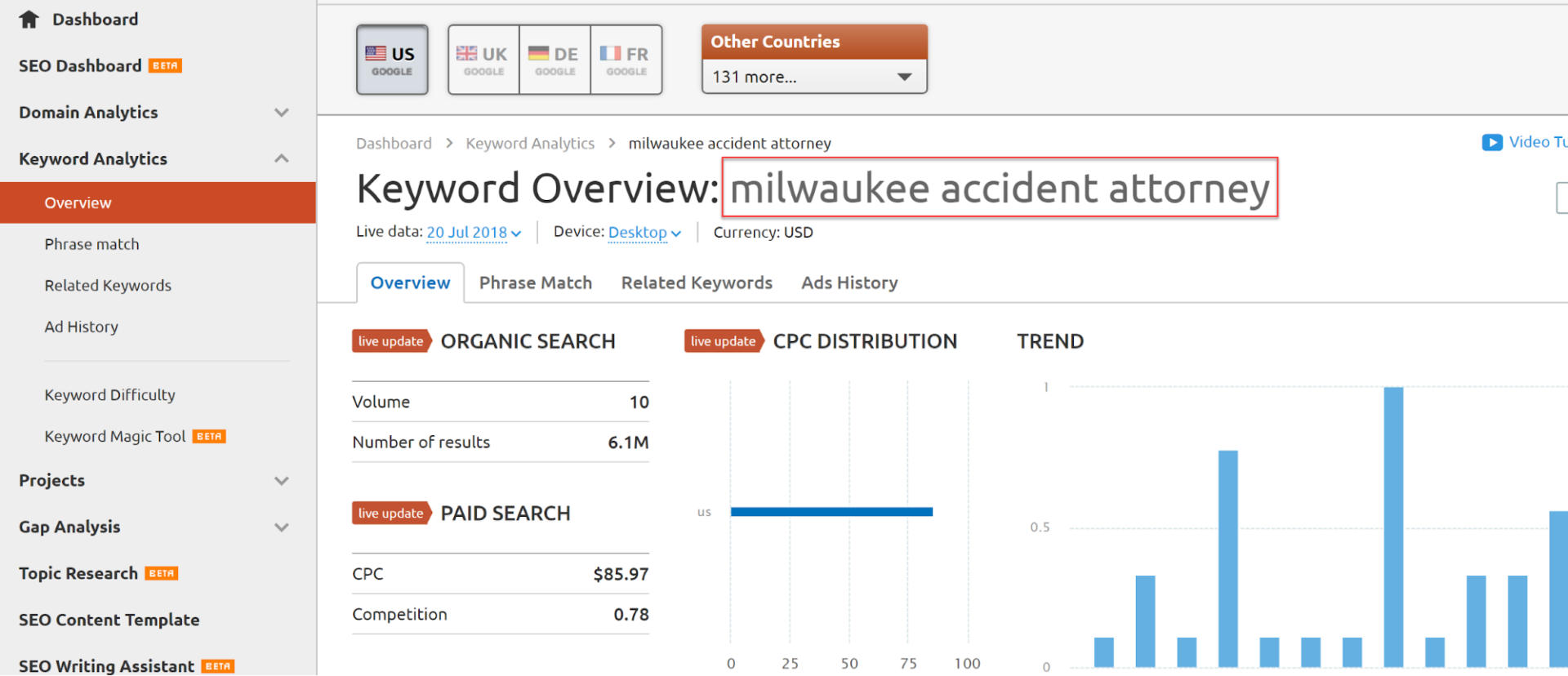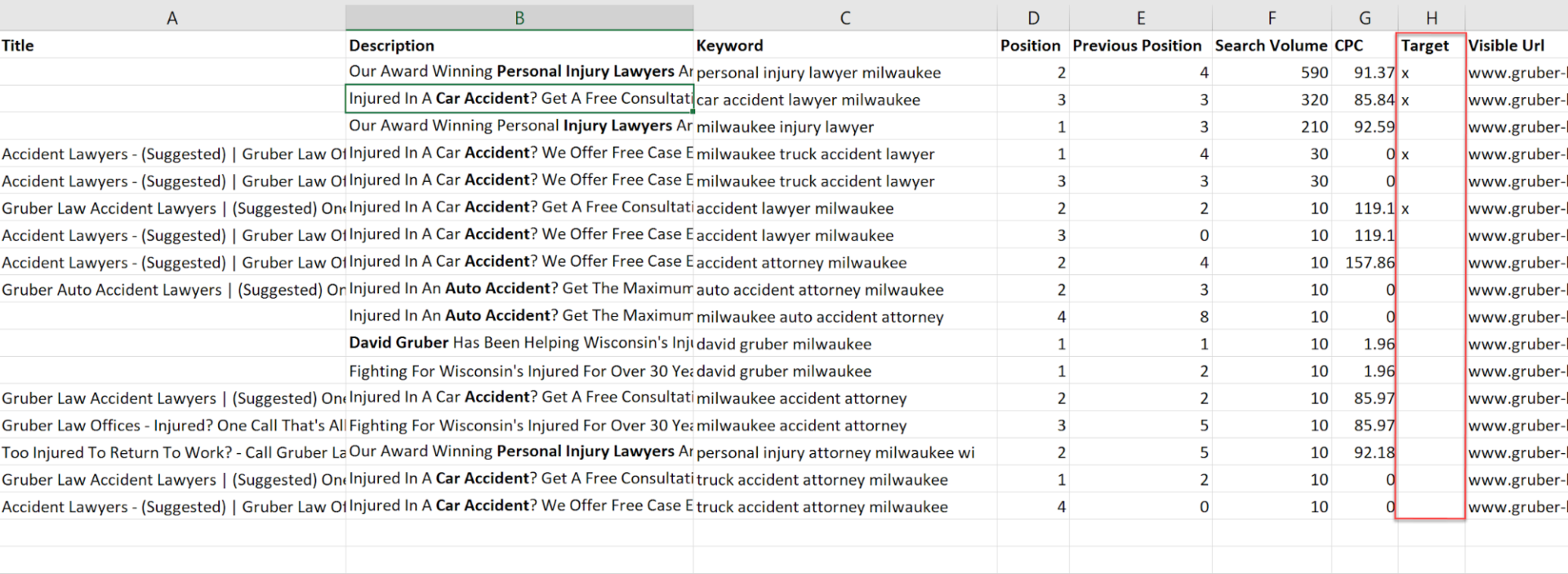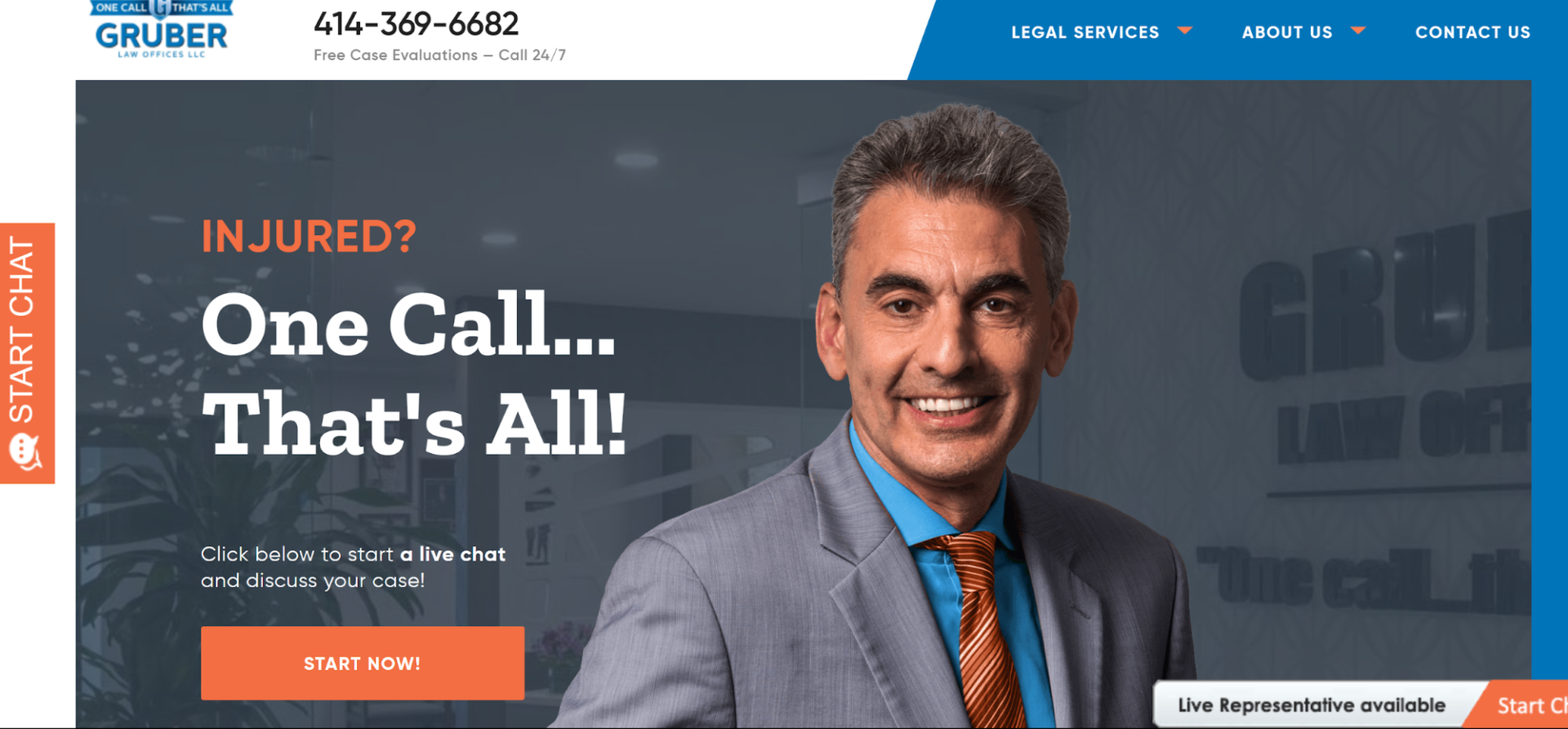PPC is the ultimate double edge sword.
Get it right, and drive a consistent stream of qualified leads to your law firm. Get it wrong, and burn through a lot of cash with little to show for it.
There are 3 things that make the edge of the PPC sword so sharp for lawyers:
- Legal keywords are expensive: it’s not uncommon to see terms like “personal injury lawyer” and “criminal DUI attorney” go for over $100 per click in larger markets. Law firms can easily spend $50,000 – $100,000 per month on PPC.
- Competition is brutal: everyone is fighting for prized real estate at the top of the search results. Higher levels of competition go hand in hand with expensive keywords, while making it hard to stand out in a sea of attorneys.
- Getting qualified traffic is difficult: not all traffic is created equal. Lawyers often make the mistake of targeting keywords with low intent. The result? A lot of traffic, but few conversions.
Due to the high cost and level of competition, it’s critical for attorneys to see a quick return on their investment.
But:
Creating a profitable PPC campaign from scratch can seem daunting. After all, there are a lot of moving pieces – keywords, ad copy, landing page optimization, nurture series, A/B testing. Get any one of those pieces wrong, and you risk wasting a lot of time and money.
Luckily, you don’t need to reinvent the wheel. In this post, I’m going to walk you through a simple 5-step PPC framework our agency uses to get attorneys more qualified case consults and phone calls.
Here is a breakdown in case you want to jump to a specific step in the process:
Step #1: Identify Your Top Paid Competitors
Step #2: Find High Value Keywords
Step #3: Win The Click With Killer Ad Copy
Step #4: Convert Visitors
Step #5: Nail The Post-Conversion Experience
Ok, let’s jump in…
Step #1: Identify Your Top Paid Competitors
The first step in the process is to identify the top paid search competitors in your market. There are a couple ways to do this:
Google Search
Head over to Google and enter one of your firm’s top practice areas:

The paid ad results will immediately surface the top players in your space.
Note: If you decide to look for competitors in the search results, always start with the most competitive top-level practice area. Since the legal industry has some of the most expensive keywords, you know anyone ranking in the top 3 ad positions has a healthy PPC budget and is likely bidding on a decent number of high value keywords:

(Source)
SEMrush Advertising Competitors
The team here at Virayo use SEMrush a lot when it comes to dissecting competitor SEO and PPC campaigns.
I’ll be using SEMrush to walk you step-by-step through the remainder of the competitor analysis process.
Enter your main top-level practice area and location into the search bar:

Next, scroll to the bottom of the keyword report to see a list of all the competitor ad copies:

Make a note of the domains shown below the main ad copy headline.
If your firm is operating in a smaller market with less competitors and data to analyze, its helpful to branch out to larger cities. Look for firms in places like New York, LA, Philadelphia and Houston serving the same practice areas.
Action Item: Using the tactics shown above, build a list of 5-10 paid search competitors, or similar practicing attorneys operating in larger markets.
Bonus Resource: 34 Ways to Analyze Online Competitors with SEMrush
Step #2: Find High Value Keywords
The next step in the process is to ensure your business shows up in the search results at the exact moment someone is searching for the services you offer.
How do you do this?
Keywords.
Grab one of the domain URLs you collected in the previous step and paste it into SEMrush. Go to the Domain Analytics >> Advertising Research >> Positions Report:

The report will show top-level data related to:
- # keywords being bid on
- Amount of traffic from paid ads
- Cost of the paid ad traffic
- Trend graphs over time
Note: Please view the top-level metrics as a relative measure, not an definitive metric.
This data is helpful in determining which competitors are spending the most on paid ads, and how activity is trending over time.
But:
At this point, we’re mostly interested in building a shortlist of keywords to bring in more qualified traffic and cases.
Scroll to the bottom of the overview page and to view the Paid Search Positions report:

In this case, the report shows Gruber Law bidding on 17 different keywords, along with a number of different data points:
Position: where the domain ranks in the paid search results for a given keyword.
Volume: average number of times users have searched for a given keyword in a month.
CPC: average cost for the click triggered by the keyword.
URL: where the domain is sending traffic from ads.
Action Item: Scan through the list of keywords for each of the domains you collected in the previous step and check the box next to any terms related to the services you offer:

Create a master keyword list across each of the competitors and export when ready:

The export will contain all the data points shown inside the SEMrush application.
To simplify, I like to create a new column called “Target” and move down placing an “x” next to any terms that look like a good fit.
Bonus tip: As you’re working through the list pay close attention to the intent of the keywords. You might come across competitors with very large budgets who are bidding on more top funnel informational keywords like “Miami traffic accidents”. For most of our clients, we recommend focusing first on middle and bottom funnel search terms since they have the most buying intent.
(i.e. people search for lower funnel terms are closing to the point of requesting a free consult and hiring an attorney)
For example:
“[Location] accident attorney” (Bottom funnel – ready for a consult)
“best truck accident attorney” (Middle funnel – evaluating options in the research phase)

The next step in the process is to break out all the marked keywords into topical buckets. This is an important step in structuring optimized AdWords campaigns and ad groups (important for quality score):

Bonus Resource: PPC Keyword Research
Step #3: Win The Click With Killer Ad Copy
Building the keyword set and getting your business in front of a targeted audience is only half the battle.
The next part of the PPC equation is to turn all those new impressions into traffic. You need to win the click.
But, here’s the problem:
Look at the paid ads and you’ll notice they all kind of sound the same:

…Primary keyword in the title.
…Free consultation offer.
For busy attorneys, it can be a challenge to come up with unique copy to win the click.
Enter the SEMrush Ad Copy report.
Enter in a competing domain and go to the Advertising Research >> Ad Copies report:

You’ll see the title, description, landing page URL and specific keywords triggering each ad.
While this data alone is great for generating new ad copy ideas, it doesn’t tell you if the copy is actually converting.
So:
You need to drill in further to identify which ads are performing the best.
SEMrush makes this easy. Go to the Advertising Research >> Ad History report:

The report shows how long a company has been running specific ads. This insight is valuable because if businesses spending a lot of money on AdWords have been running the same ad for several consecutive months, you can infer it’s performing well (i.e. getting a solid click-through rate and driving traffic).
Action Item: Find the longest running ads and look at the following:
Title: Do they include the target keyword? Are they using emotion? Asking a question?
Description: What details are used to differentiate the firm from others? Offer?
Finally, type in the primary keyword to see what type of ad extensions competitors are using:

Don’t get bogged down with writer’s block. Model your ad copy off the competitors who are already winning the click in non-competing geographic markets.
Bonus Resource: 8 PPC Ad Copy Tips
Step #4: Convert Visitors
Traffic means nothing unless it converts.
Since legal keywords are so expensive, you can’t afford to waste a single click. It’s critical to have a high-converting landing page in place.
Rather than trying to come up with an optimized landing page design from scratch, use SEMrush to quickly identify how the competition is converting paid traffic into leads and cases.
Access this data from either the Keywords, Ad Copy or Ad History reports:

Click the URL next to the keyword or ad and you’ll be taken to the competitor landing page:

Action Item: Look at the landing pages of top PPC competitors. These businesses are spending a LOT of money driving traffic to these pages, so they are likely running tests to optimize for conversion.
By looking at the landing pages you can eliminate a lot of guesswork and start with an optimized page design that is positioned to turn more traffic into case leads.
Here is a checklist of items to look at:
- Headline: What value proposition are they offering?
- CTA: Do they have an offer or call-to-action above the fold? How often do they repeat it?
- Forms: What type of information do they ask for? Do they use live chat?
- Offer: What are they offering to visitors – free consult, live chat etc?
- Navigation: Do they have main navigation or is the only option to click the CTA?
- Social proof: Do they leverage social proof – testimonials, reviews, awards, stats – to build credibility?
- Differentiation: How do they differentiate – cases won, experience, case value?
- Length: How long is the page? How much text?
- Media: What is the image and video-text ratio? How do they improve readability?
The idea here is not to copy, but instead model proven landing page designs.
Bonus Resource: 15 PPC Landing Page Best Practices
Step #5: Post-Conversion Experience
Marketers place a lot of emphasis on conversions – and for good reason.
Conversions (form fills/ phone calls) = success in the eyes of any law firm. But of course, the path to a closed deal rarely ends with the form fill.
In most cases, the relationship needs to be nurtured if you want to guide leads down the path to a paying client.
A nurturing sequence can go in a lot of different directions. Instead of trying to reinvent the wheel and create one from scratch, take a look at what the top firms in the largest markets are doing to nurture new leads.
The easiest way to do this is create a dummy email and fill out some forms on competitor landing pages.
Here are some things to note:
- How long from form fill to follow up phone call?
- Do you receive any follow up emails? How many? Frequency? What type of content is sent (case studies etc)?
- Do you receive a legal newsletter after the follow up series ends?
- Do you get retargeted on facebook, LinkedIn, Google and other online channels?
Here is an example of a basic law firm lead nurturing campaign:
Campaign Trigger: an action that signals some level of intent to become a client, such as a form fill.
Email #1: Client testimonial and/or case study (preferrably related to lead’s case)
Email #2: Answer the most common FAQs (eg: pricing structure and what it means for clients)
Email #3: Introduction to relevant attorneys (personalize)
Email #4: Emphasize the current workload, and stress importance of getting in touch soon.
Email #5: (Optional): Highlight the importance of acting quickly on the case in circumstances where the lead has a certain window to file a case before losing the ability to get compensation.
Putting a lead nurture sequence in place can help your firm close leads that otherwise would have gone cold without active follow up.
The best part?
The entire sequence can be automated with a CRM or email service provider.
Ready, Set, Convert
Don’t waste time and money trying to crack the PPC code. Your competitors have already done a lot of the heavy lifting for you.
Follow this simple 5-step framework and you’ll be able to jump straight out of the gates with a campaign that drives a consistent stream of case consultations and phone calls to your law firm.
If you’d like help with your PPC campaign management, click the button below to set up a free consultation with one of our paid ad experts.




